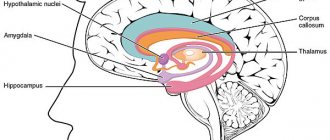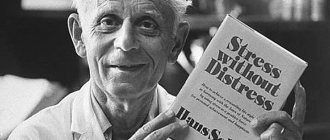My main stressors
What are stressors?
Of course, you've heard of stress, and you may even have experienced a good amount of it today. But do you know what the difference is between “stress” and “stressors”? Stressors are situations that are experienced as a perceived threat to a person's well-being or position in life, where the task they are dealing with exceeds the resources available to them.
When a person encounters stressors, the body's stress response is triggered and a series of physiological changes occur that allow the person to fight or flee.
If this formulation sounds like stress, it's because sometimes when people talk about "stress" in their lives, they're really talking about stressors; Stressors lead to the body's stress response and the experience of stress. Basically, it is important to remember that stressors cause stress.
Principle of action on the body
The state of stress has several stages of impact on the human body:
- Anxiety stage At the first stage, a person feels anxiety and discomfort. At the anxiety stage, disruption of the adrenal glands and gastrointestinal tract can be observed.
- Resistance stage At the next stage, the body's resistance to the source of stress increases. At the resistance stage, antibodies begin to be produced, symptoms of anxiety are almost invisible, and the nervous system prepares the body for resistance.
- Exhaustion stage At the final stage, physical and emotional exhaustion occurs if the body is unable to withstand stress. The immune system suffers, which is why, under the influence of stress, people are more susceptible to infections and colds. At the stage of exhaustion, all the body’s protective resources run out, and signs of anxiety reappear, which can develop into a form of nervous breakdown.
In the early stages, stressors can play a positive role. With a short-term impact and low significance, they increase the level of productivity and concentration, the volume of information perception and attention increases, and flexibility of thinking appears.
Psychological stressors
What situations become stressors?
What situations are stressors? This may vary from person to person. While certain things tend to stress out for many people—job demands, relationship conflicts, busy schedules—not every potential stressor causes stress for everyone. Because everyone has a unique set of resources, understanding of the world, and way of perceiving things; What seems a threat to one person may be perceived as a challenge to another.
Sometimes these differences can go unnoticed—it might not occur to you that a trip to the mall could be a stressor, but for someone who hates crowds and shopping, a day at the mall can be a major stressor.
You may even be one of those people who hate crowds and come home from a shopping trip without understanding why you feel stressed.
Other times, you may notice whether something hits you as stress or as a simple experience, and you may even be able to change the way you think about it. You can begin to look at things differently, you can give them a different meaning, you can begin to control the situation, and you can build your stress tolerance so that fewer things are perceived as stress.
Or you can work on eliminating avoidable stressors in your life.
what is it, types and signs
In psychology, a state of increased nervous excitability is considered as a reaction to external actions. All people are susceptible to this condition, but their ability to tolerate external pressure differs. It is important to know the psychological symptoms of stress in order to recognize it in time and learn to resist.
The concept of stress in psychology: forms and characteristics of the condition
The term “stress”, derived from the English stress, literally translates as pressure, tension, load. In psychology, stress is understood as a special set of body reactions that occur in response to external unfavorable factors. When experiencing external pressure, the state of the body changes: physical processes accelerate, the nervous system works in an enhanced mode.
There are two types of stress: positive and negative. It depends on the characteristics of the influencing factors and the person’s personal attitude towards them.
Prolonged exposure to external pressure exhausts the body. Therefore, its impact must be reduced and weakened, otherwise even positive stress will lead to negative consequences.
Study of the phenomenon of stress: history of the concept, separation into a separate category
The first researcher to use the word stress to define a specific emotional and physiological state was W. Cannon. He studied the difference in the body's reactions to danger, and identified a certain set of symptoms that the body showed in response to external aggression.
The first scientific work that described the stress reaction in detail was written by G. Selye in 1936. Considering the general adaptation syndrome, the physiologist noted a special condition in which an individual’s nervous tension increases. But since the term stress was not yet in common use, Selye did not use it. It became firmly established only after 10 years, and has since been used in psychology and psychiatry.
Features of physiological processes during stress
Selye describes a stressful state as a nonspecific response of the body to external factors. They can be significant or unnoticeable; in some situations, a person’s consciousness cannot fix the cause of the experience. But the body's reaction appears regardless of whether the external pressure is conscious.
While still a student, Selye came to the conclusion that the reaction to damage or threat is the same for different people. He looked at the signs of infection: all the sick people showed symptoms at the same time and with similar intensity. His experiments with rats, and later his experiments with humans, yielded similar conclusions: living organisms, when faced with danger or injury, react in the same way. The nature of the damage does not matter. The identification of the universality of symptoms made it possible to identify three main factors:
- enlargement of the adrenal cortex;
- reduction of the thymus;
- hemorrhage in the stomach and intestines.
By combining the signs into a triad, Selye formed the idea of a general adaptation symptom.
Features of general adaptation symptoms: stages and physical changes
The results of his own experiments helped Selye identify 3 stages of OSA:
- Anxiety - the body mobilizes internal resources.
- Resistance is active resistance to external influence.
- Exhaustion - consumption of resources, feeling tired.
At first, Selye perceived the phenomenon of stress negatively, as a reaction to an unpleasant situation. But experiments have shown that the attitude towards the source of stress does not affect the activity of symptoms. The pleasant effect has an equally destructive effect on the nervous system.
Features of adaptive energy: the concept of adaptation of the body
When considering stress, Selye suggested that the ability to adapt (the ability to withstand external pressure) differs from person to person. Individual differences depend on the amount of energy contained in the body. The amount of energy is approximately the same for representatives of the same species (the level of resistance of rats is different from the level of resistance of dogs). Physiological experiments with people have shown that the reaction of men and women of the same age is also the same.
The researcher formed the concept of adaptive energy, consisting of the following statements:
- Energy is limited. Its volume is inherited and is always limited.
- Energy can be concentrated. The body constantly has a distributed supply of energy that can be combined to effectively respond to an external challenge.
- Energy is not always active. Adaptive energy is activated when external influence reaches a certain threshold.
- Energy has two levels of activity. The first level responds to a high level of threat and wastes a large supply of energy at once, the second responds to a weak threat, spending energy sparingly.
The theory of adaptive energy was considered by Selye's follower Goldstone. He considered it an important discovery, but did not share Selye’s opinion about the hereditary nature of the volume of energy. According to Goldstone, energy reserves can be developed and replenished by increasing the body's ability to cope with external stimuli. He also found that constant exposure to weak stimuli increases the adaptive response.
Goldstone suggested that negative signals affect the body every day, and a person copes with them successfully. Weak stimuli keep the nervous system in good shape, while consuming almost no energy. Strong stimuli take up more energy and deplete the supply. Complete exhaustion leads to the death of the body. The strength of adaptation depends not on the strength of the stimulus, but on the characteristics of individual reactions.
Goldstein came to the conclusion that adaptive energy is produced throughout life. The production rate gradually decreases, but the accumulated capital remains. Emotional and physical exhaustion occurs when a person expends more energy than he produces. Modern science considers the obligatory energy reserve as an evolutionary defense mechanism.
Differences in types of stress depending on the form of manifestation and characteristics of influencing factors
Among the types of stress, the following types are distinguished:
- Eustress - caused by positive emotions, mobilizes the body, helps to cope with everyday difficulties.
- Distress - appears when an external stimulus is too strong and the body cannot cope with it. Distress has a devastating effect on health, reducing the functioning of the immune system. Finding yourself in a situation of severe nervous tension, a person is more likely to suffer from infectious diseases.
- Emotional – accompanies an emotional response. The emotional reaction is primary; its activation causes other systems to work.
- Post-traumatic - occurs in response to a strong shock. The catalyst for tension is negative memories.
- Psychological - most often caused by social factors. To stop it, you need to get out of the provoking situation.
- Professional – associated with increased stress during professional activities.
Types of stress are often combined with each other in situations of increased life threat. In everyday life, most people experience psychological stress, but its pressure is low or moderate and does not cause exhaustion of the nervous system.
The role of stress during interrogation, the influence of stress factors when manipulating people
Stress factors are often used by investigators to influence suspects. To do this, during interrogation, various methods are used that affect the physical and mental state of the interrogated:
- the interrogation is carried out in a room with a temperature below normal by 2–3 degrees;
- the investigator asks questions quickly, puts emotional pressure on the suspect;
- if there is no response, the person being questioned is subject to cross-examination.
An increase in the level of psychological pressure makes it difficult for the suspect to concentrate, making him irritated, angry or scared. In this state, he quickly loses the ability to self-control and gives up.
With manipulative influence, the artificial creation of a hostile, dangerous environment helps to obtain the desired result. The manipulator instills false beliefs, intimidates or angers the target in order to activate defense mechanisms. While a person is under stress, it is easy to convince him and impose his opinion.
Misconceptions: what you need to know about real emotional stress and its consequences
Common misconceptions surrounding stress that prevent people from coping effectively with its effects include:
- Stress only causes extreme shock. The strength of influence is determined not by objective factors, but by the characteristics of perception. Therefore, an event that is insignificant for one person can be devastating for another.
- A strong shock only affects the nervous system. Stress affects all organ systems and can lead to various diseases.
- Children cannot experience stress. Research has shown that newborn babies already have an active defense mechanism to respond to changes in the external environment.
To distinguish a real stressful state from other psychological manifestations, it is necessary to know the main symptoms and the process of development of the response.
How the adaptive response to the external environment develops: stages of stress
Understanding the principles of response development helps to recognize the first signs of a negative impact and take timely measures. Selye identified the phases of development of the stress reaction by defining physical symptoms:
- Anxiety and mobilization, preparation for adaptation. The body mobilizes its resource reserves, preparing to respond to external influences. Manifested by rapid heartbeat, anxiety, and muscle tension.
- Resistance, consolidation of new parameters of the body. The adaptive reserve of forces is redistributed, removing the consequences of external influence. A high level of adaptability helps to completely restore the normal state; a low level may not cope.
- Depletion of energy reserves. A long stay in the third phase can completely destroy the energy supply, causing various diseases, including severe internal bleeding.
An individual cannot endlessly resist the influence of stimuli, so it is important to prevent the development of the exhaustion stage and use preventive measures.
How to maintain normalcy in a negative environment: quick ways to calm down
The main task of studying the concept of stress in psychology was the discovery of methods to help cope with its destructive effects. These methods include:
- Rapid breathing. To normalize your emotional state, you need to help your body relieve tension. A rapid breathing exercise is suitable for this: 3 inhalations and 3 exhalations for 1 second.
- Grounding. In psychology, grounding is understood as a state in which a person concentrates on bodily sensations. To increase concentration, you need to increase tactility: clasp your hands, sit down, stomp your feet.
- Suspension. If negative consequences cannot be changed, you should distance yourself from them. To do this, you need to focus on one object that evokes positive emotions.
Following a routine, regular walks, and proper rest helps increase stress resistance.
Useful video
From the video you will learn how to get rid of stress and how to manage it.
mystroimmir.ru
Stressors include:
- Top Causes of Stress: Are you worried about the same things that cause stress in most people? Here are some of the main causes of stress and how to manage them.
- Work - Stress and how it affects you: Some work factors that are significant stressors for most people. How does your job affect you and how can you manage stress?
- Relationship strain is a conflict issue: Relationship conflict is one of the more severe stressors that people face in this conflict. This type of stress affects more people than most other stressors we face in life. Find out why and what you can do to minimize stress.
- Managing the Stress of a Busy Life: Even a fun, busy life can be a stressor if it leaves you with little time to take care of yourself. Here's why a busy life can be a stressor, and how you can cope with this type of stress.
Family crises
Vertical and horizontal stressors arise in the family. The basis of such factors is the upbringing of children, myths about family life embedded in the new generation. Vertical factors run through the beliefs that each spouse received in childhood. Vertical stress factors are formed in three or more generations: these are misconceptions about the position of husband and wife, about their role and main responsibilities.
Horizontal factors refer to the stages of family relationships. At their core, such problems arise due to external difficult situations: lack of money, problems with housing and organizing family life.
Horizontal factors are based on material values and do not relate to the spiritual life of the family. Normative crises manifest themselves at the stage of formation of family life. The clash of values and principles creates normative crises in future family life. In regulatory crises, horizontal and vertical factors can be involved. The role of such stressors is determined by the origin of the partners and their upbringing.
Family quarrels, another type of stressor
what is it, types, mechanism of influence
The term stressor is a nonspecific irritating factor that causes a state of stress.
What is a stressor?
Stress factors lead to emotional burnout of a person. This is a long-term adverse effect that has a strong impact on the psyche. This meaning can be assigned by the person himself, or the body classifies it this way through the lower sensory mechanisms of the brain, the digestive and metabolic system. The degree of manifestation depends on the level of stress resistance.
External factors include environmental pollution, consumption of alcoholic beverages and smoking, prolonged exposure to the sun and burns, high levels of responsibility and workload, personal problems, and emotional distress.
Internal factors include various food allergic reactions, autoimmune diseases, accelerated metabolism, high cholesterol, low blood sugar or vice versa, hormonal imbalance, unbalanced diet, depression caused by insufficient amounts of minerals in the body, sleep disturbances, insomnia , low level of self-esteem, long-term chronic diseases.
Types of stressors
According to the classification, stressors are of the following types: short-term and long-term.
Short-term ones arise unexpectedly and can recur after some time. Such factors have virtually no impact on the nervous system and human life. These include:
- Bad moments and failures. When an individual remembers some unpleasant moment from his life or someone reminds him of it, the stressor can have the same strength as at the moment when this event occurred.
- Temperature changes, high noise levels, bright light. These are external stimuli that provoke a stressful state.
- Fear and criticism. Both of these factors can lead to stress.
- Speed. If a subject is forced to do something quickly, he is under the influence of a stressor.
Long-term ones can affect both the physical and mental state of a person. These factors include:
- complete isolation from society;
- extreme lifestyle or dangerous activity;
- constant resistance to the environment;
- overwork or prolonged performance of routine work.










